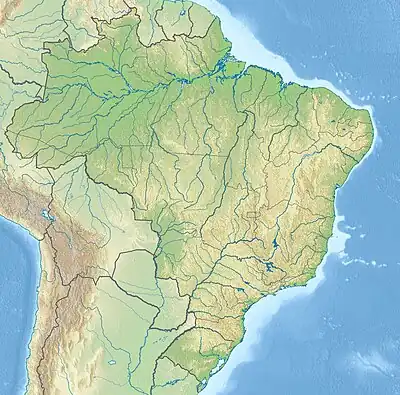| Quiricó Formation | |
|---|---|
| Stratigraphic range: Aptian | |
 Stratigraphic position of the Quiricó Formation in São Francisco Basin | |
| Type | Geological formation |
| Unit of | Areado Group |
| Underlies | Abaeté Formation |
| Overlies | Três Barras Formation |
| Thickness | 60–100 m (200–330 ft) |
| Lithology | |
| Primary | Sandstone, claystone |
| Other | Siltstone, limestone |
| Location | |
| Coordinates | 16°42′S 44°24′W / 16.7°S 44.4°W |
| Approximate paleocoordinates | 17°30′S 11°54′W / 17.5°S 11.9°W |
| Region | |
| Country | |
| Extent | São Francisco Basin |
| Type section | |
| Named for | Quiricó Lake/River |
| Named by | Barbosa |
| Year defined | 1965 |
 Quiricó Formation (Brazil) | |
The Quiricó Formation is a geological formation of the Areado Group in Minas Gerais, Brazil whose strata date back to the Lower Cretaceous (Early Cretaceous).[1] Many occurrences of fossils are reported in the lacustrine deposits of the Quiricó Formation.
Fossil content
- Neokotus sanfranciscanus[2]
- Tapuiasaurus macedoi[3]
- Dastilbe moraesi[4]
- Laeliichthys ancentralis[5]
- Spectrovenator ragei[6]
- Cryptobicuspidon pachysymphysealis[7]
- Abelisauridae indet.[8]
- Carcharodontosauridae indet.[8]
- Rebbachisauridae indet.[8]
References
- ↑ Sgarbi, 2000
- ↑ Souza Bittencourt et al., 2020
- ↑ Zaher et al., 2011
- ↑ Santos, 1955
- ↑ Santos, 1985
- ↑ Zaher et al., 2020
- ↑ Carvalho, J. C.; Santucci, R. M. (2023). "A new fossil Squamata from the Quiricó Formation (Lower Cretaceous), Sanfranciscana Basin, Minas Gerais, Brazil". Cretaceous Research. 105717. doi:10.1016/j.cretres.2023.105717.
- 1 2 3 Carvalho and Santucci, 2018
Bibliography
- Souza Bittencourt, Jonathas; Tiago Rodrigues Simões; Michael Wayne Caldwell, and Max Cardoso Langer. 2020. Discovery of the oldest South American fossil lizard illustrates the cosmopolitanism of early South American squamates. Communications Biology 3(1). Article number 201. . doi:10.1038/s42003-020-0926-0 PMID 32350412 PMC 7190622
- Zaher, H.; D. Pol; A.B. Carvalho; P.M. Nascimento; C. Riccomini; P. Larson; R. Juarez Valieri; R. Pires-Domingues, and N.J. and Campos, D.A. da Silva. 2011. A Complete Skull of an Early Cretaceous Sauropod and the Evolution of Advanced Titanosaurians. PLoS ONE 6(2). e16663. . doi:10.1371/journal.pone.0016663 PMID 21326881 PMC 3034730 Bibcode:/abstract 2011PLoSO...616663Z
- Sgarbi, G.N.C. 2000. The Cretaceous Sanfranciscan Basin, Eastern Plateau of Brazil. Revista Brasileira de Geociências 30(3). 450–452. . doi:10.25249/0375-7536.2000303450452
- Santos, R.S. 1985. Laeliichthys ancestralis, novo gênero e espécie de Osteoglossiformes do Aptiano da Formação Areado, Estado de Minas Gerais, Brasil. Colet. Trab. Paleontol. Ser. Geol. 27. 161–167. .
- Santos, R.S. 1955. Descrição dos peixes fósseis. Bol. Min. Agr. Div. Geol. Mineral., Rio de Janeiro 155. 1–211. .
- Zaher, H. 2020. An Early Cretaceous theropod dinosaur from Brazil sheds light on the cranial evolution of the Abelisauridae, 101-115. 19; doi:10.5852/cr-palevol2020v19a6
- Carvalho, Joyce Celerino de, and Rodrigo Miloni Santucci. 2018. New dinosaur remains from the Quiricó Formation, Sanfranciscana Basin (Lower Cretaceous), Southwestern Brazil. Cretaceous Research 85. 20-27. .
This article is issued from Wikipedia. The text is licensed under Creative Commons - Attribution - Sharealike. Additional terms may apply for the media files.